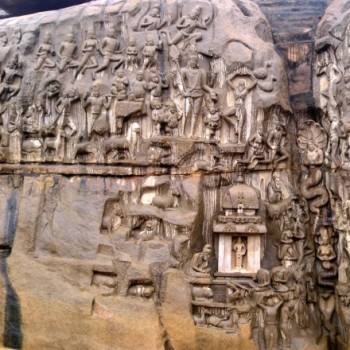Significance of Arjuna’s Penance in Mahabalipuram

Posted on
August 8, 2014 by
Vishnu

Descent of the Ganges/ Arjuna’s Penance, is a popular monument from the Pallava age in Mahabalipuram. Measuring approximately 30m (100ft) long and 15m (45ft) high, it’s an open air rock carving which depicts the story of how the holy river Ganges came into earth from the heavens led by Arjuna. It’s a giant open-air relief carved out of two monolithic rock boulders. Archaeologists suggest the structure is arguably the best rock cut sculpture in India. It’s a designated UNESCO World Heritage Site since the year 1984.
The story:
Arjuna’s Penance is a depiction of an instance in the Indian epic ‘Mahabharata’. It tells severe austerities that had to be performed by Arjuna in order to obtain Shiva’s weapon. According to myth if one can put themselves through rigorous tests to prove to the gods of their devotion and strength in will, it’s believed the gods would grant them boons of their choice.
Description:
The carving is composed of the depictions of the natural world on the left side and celestial world on the right side. A bifurcated crater in the middle filled with nagas separates the two worlds. In this crater water was poured in order to create a natural waterfall (the Ganges’ descent). To the left top you can see Arjuna in a yogic posture standing on a single leg and his arms raised up. Behind him Shiva is depicted with miniature ganas as attendants. In the right side there is a very prominent carving of an elephant with its young and various celestial angels looking on.
Stay in one of the best hotels in Mahabalipuram and Discover ancient India. Visit www.hotelmamallaheritage.com to know more.